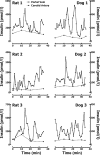Measurement of pulsatile insulin secretion in the rat: direct sampling from the hepatic portal vein
- PMID: 18577690
- PMCID: PMC2536733
- DOI: 10.1152/ajpendo.90335.2008
Measurement of pulsatile insulin secretion in the rat: direct sampling from the hepatic portal vein
Abstract
It has previously been shown that insulin is secreted in discrete secretory bursts by sampling directly from the portal vein in the dog and humans. Deficient pulsatile insulin secretion is the basis for impaired insulin secretion in type 2 diabetes. However, while novel genetically modified disease models of diabetes are being developed in rodents, no validated method for quantifying pulsatile insulin secretion has been established for rodents. To address this we 1) developed a novel rat model with chronically implanted portal vein catheters, 2) established the parameters to permit deconvolution of portal vein insulin concentrations profiles to measure insulin secretion and resolve its pulsatile components, and 3) measured total and pulsatile insulin secretion compared with that in the dog, the species in which this sampling and deconvolution approach was validated for quantifying pulsatile insulin secretion. In rats, portal vein catheter patency and function were maintained for periods up to 2-3 wk with no postoperative complications such as catheter tract infection. Rat portal vein insulin concentration profiles in the fasting state revealed distinct insulin oscillations with a periodicity of approximately 5 min and an amplitude of up to 600 pmol/l, which was remarkably similar to that in the dogs and in humans. Deconvolution analysis of portal vein insulin concentrations revealed that the majority of insulin ( approximately 70%) in the rat is secreted in distinct insulin pulses occurring at approximately 5-min intervals. This model therefore permits direct accurate measurements of pulsatile insulin secretion in a relatively inexpensive animal. With increased introduction of genetically modified rat models will be an important tool in elucidating the underlying mechanisms of impaired pulsatile insulin secretion in diabetes.
Figures





Similar articles
-
Human insulin release processes measured by intraportal sampling.Am J Physiol Endocrinol Metab. 2002 Mar;282(3):E695-702. doi: 10.1152/ajpendo.00516.2000. Am J Physiol Endocrinol Metab. 2002. PMID: 11832375
-
Pulsatile insulin secretion accounts for 70% of total insulin secretion during fasting.Am J Physiol. 1995 Sep;269(3 Pt 1):E478-88. doi: 10.1152/ajpendo.1995.269.3.E478. Am J Physiol. 1995. PMID: 7573425
-
Adaptations in pulsatile insulin secretion, hepatic insulin clearance, and beta-cell mass to age-related insulin resistance in rats.Am J Physiol Endocrinol Metab. 2008 Oct;295(4):E832-41. doi: 10.1152/ajpendo.90451.2008. Epub 2008 Jul 29. Am J Physiol Endocrinol Metab. 2008. PMID: 18664594 Free PMC article.
-
Non-esterified fatty acids and the liver: why is insulin secreted into the portal vein?Diabetologia. 2000 Jul;43(7):946-52. doi: 10.1007/s001250051474. Diabetologia. 2000. PMID: 10952470 Review.
-
Measurement of Pulsatile Insulin Secretion: Rationale and Methodology.Metabolites. 2021 Jun 22;11(7):409. doi: 10.3390/metabo11070409. Metabolites. 2021. PMID: 34206296 Free PMC article. Review.
Cited by
-
The elusive cephalic phase insulin response: triggers, mechanisms, and functions.Physiol Rev. 2023 Apr 1;103(2):1423-1485. doi: 10.1152/physrev.00025.2022. Epub 2022 Nov 24. Physiol Rev. 2023. PMID: 36422994 Free PMC article. Review.
-
Gene expression patterns in synchronized islet populations.Islets. 2019;11(2):21-32. doi: 10.1080/19382014.2019.1581544. Epub 2019 May 3. Islets. 2019. PMID: 31050588 Free PMC article.
-
Pulsatile portal vein insulin delivery enhances hepatic insulin action and signaling.Diabetes. 2012 Sep;61(9):2269-79. doi: 10.2337/db11-1462. Epub 2012 Jun 11. Diabetes. 2012. PMID: 22688333 Free PMC article.
-
The Effects of Butyrate on Induced Metabolic-Associated Fatty Liver Disease in Precision-Cut Liver Slices.Nutrients. 2021 Nov 24;13(12):4203. doi: 10.3390/nu13124203. Nutrients. 2021. PMID: 34959755 Free PMC article.
-
Blood glucose control using a novel continuous blood glucose monitor and repetitive intravenous insulin boluses: exploiting natural insulin pulsatility as a principle for a future artificial pancreas.Int J Endocrinol. 2013;2013:245152. doi: 10.1155/2013/245152. Epub 2013 Nov 27. Int J Endocrinol. 2013. PMID: 24369461 Free PMC article.
References
-
- Akaike H An information criterion (AIC). Math Sci 14: 5–9, 1976.
-
- Basu R, Breda E, Oberg AL, Powell CC, Dalla Man C, Basu A, Vittone JL, Klee GG, Arora P, Jensen MD, Toffolo G, Cobelli C, Rizza RA. Mechanisms of the age-associated deterioration in glucose tolerance: contribution of alterations in insulin secretion, action, and clearance. Diabetes 52: 1738–1748, 2003. - PubMed
-
- Bertram R, Sherman A, Satin LS. Metabolic and electrical oscillations: partners in controlling pulsatile insulin secretion. Am J Physiol Endocrinol Metab 293: E890–E900, 2007. - PubMed
-
- Bonora E, Zavaroni I, Coscelli C, Butturini U. Decreased hepatic insulin extraction in subjects with mild glucose intolerance. Metabolism 32: 438–446, 1983. - PubMed
-
- Bratusch-Marrain PR, Komjati M, Waldhausl WK. Efficacy of pulsatile vs. continuous insulin administration on hepatic glucose production and glucose utilization in type I diabetic humans. Diabetes 35: 922–926, 1986. - PubMed
Publication types
MeSH terms
Substances
Grants and funding
LinkOut - more resources
Full Text Sources
Medical

